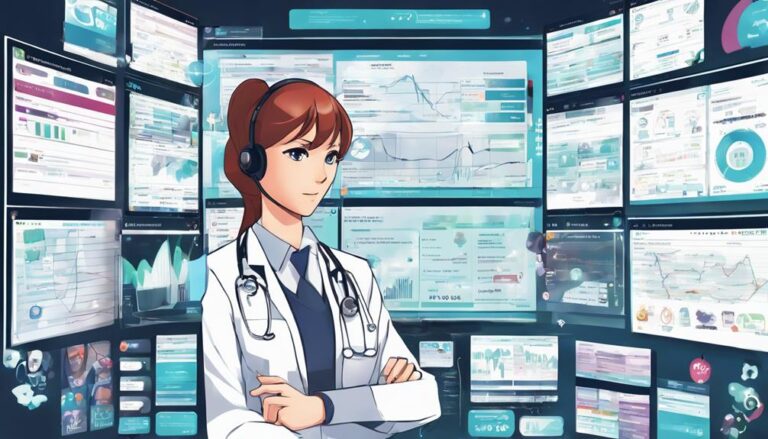The Rise of Telehealth: Implications for Healthcare Sales and Marketing
In the domain of healthcare sales and marketing, the surge in telehealth is reshaping strategies to align with digital shifts. Embrace telehealth adoption trends by showcasing remote monitoring advantages and boosting patient outcomes. Tailor sales approaches with personalized demos, partnerships, and virtual consultations. Leverage virtual platforms for marketing, engage in online events, and stay innovative with digital strategies. Navigate regulatory complexities, adapt to compliance challenges, and differentiate with proactive strategies. Evolve sales methods by focusing on patient preferences, analytics, and strong relationships. Stay ahead with cutting-edge digital marketing trends and personalized content. Uncover the transformative possibilities of telehealth for healthcare sales and marketing.
Key Takeaways
- Telehealth adoption trends show increased provider acceptance.
- Remote monitoring enhances healthcare efficiency.
- Personalized care options boost patient engagement.
- Sales strategies include remote consultations and partnerships.
- Digital marketing trends focus on targeted messaging and automation.
Telehealth Adoption Trends
When analyzing telehealth adoption trends, it becomes evident that an increasing number of healthcare providers are embracing this technology to enhance patient care and accessibility. Remote monitoring has been a key driver in this adoption wave, allowing providers to keep track of patients' essential signs, symptoms, and progress from a distance. This capability not only increases the efficiency of healthcare delivery but also enables early intervention, ultimately improving patient outcomes.
Moreover, telemedicine expansion has played an important role in facilitating greater access to healthcare services, particularly in underserved or remote areas. By leveraging telehealth solutions, healthcare providers can now reach patients who previously faced barriers to receiving timely medical attention. This expansion hasn't only widened the scope of healthcare services but has also revolutionized the way healthcare is delivered, making it more convenient and patient-centered.
As telehealth continues to evolve, the integration of remote monitoring and the expansion of telemedicine services will likely further enhance patient care, increase accessibility, and drive innovation in the healthcare industry.
Impact on Patient Engagement
With telehealth, you can expect to see enhanced virtual interactions, leading to more convenient and accessible healthcare services.
By utilizing telehealth technology, patients can experience improved health outcomes through regular monitoring and timely interventions.
Additionally, telehealth offers personalized care options tailored to individual needs, fostering stronger patient engagement and satisfaction.
Enhanced Virtual Interactions
Through the integration of enhanced virtual interactions, healthcare providers can greatly boost patient engagement and foster a more personalized approach to care delivery. Remote consultations allow patients to connect with their healthcare providers conveniently, eliminating traditional barriers like distance and travel time.
Virtual diagnostics further enhance this experience by enabling healthcare professionals to assess and diagnose patients remotely, streamlining the healthcare process. These interactions not only save time but also enhance patient satisfaction by providing quick access to care.
Improved Health Outcomes
Harnessing advancements in telehealth technology can greatly enhance patient engagement and ultimately lead to improved health outcomes. Through remote monitoring, healthcare providers can keep track of patients' essential signs, medication adherence, and overall health status without the need for frequent in-person visits. This proactive approach allows for early intervention and personalized preventative care strategies, resulting in better health outcomes for patients.
Personalized Care Options
To enhance patient engagement, healthcare providers can tailor care options to individual needs, fostering a more personalized approach to treatment. By incorporating remote monitoring technologies, providers can keep track of patient progress in real-time, allowing for timely interventions and adjustments to treatment plans.
Customized treatment plans based on patient preferences and health goals can greatly improve adherence and outcomes. Through telehealth platforms, patients can access personalized care options conveniently from their homes, increasing their engagement in the treatment process.
Offering tailored telehealth services not only enhances patient satisfaction but also boosts overall health outcomes. By embracing personalized care options that include remote monitoring and customized treatments, healthcare providers can revolutionize patient engagement and drive better results.
Sales Strategies for Telehealth
Incorporate dynamic and targeted sales strategies to effectively promote telehealth services to healthcare institutions and providers. Start by offering remote consultations to showcase the convenience and efficiency of telehealth solutions. Utilize innovative outreach techniques such as personalized email campaigns and social media engagement to capture the attention of potential clients.
Conduct virtual demos to demonstrate the user-friendly interface and features of your telehealth platform. Highlight the ease of use for both healthcare professionals and patients, emphasizing how telehealth can streamline workflows and improve patient outcomes.
Forge strategic telehealth partnerships with hospitals, clinics, and individual practitioners to expand your reach and credibility in the industry. Collaborating with established healthcare providers can help you gain access to their existing patient networks and enhance the adoption of telehealth services.
Marketing in a Virtual Environment
Elevate your marketing approach to thrive in a virtual environment by leveraging cutting-edge digital strategies tailored for telehealth services. In this dynamic landscape, staying ahead requires strategic maneuvers and innovative thinking. To excel in marketing telehealth services effectively, consider the following:
- Virtual Networking: Engage in online events, webinars, and virtual conferences to expand your reach and connect with potential clients or partners in the telehealth industry.
- Telemedicine Branding: Develop a strong and consistent brand identity that resonates with the virtual audience, highlighting the unique value proposition of your telehealth services.
- Content Optimization: Tailor your content for virtual platforms, ensuring it's engaging, informative, and optimized for online visibility to attract and retain a virtual audience.
Regulatory Considerations for Sales
Considering the intricate landscape of healthcare sales, maneuvering regulatory considerations is essential for ensuring compliance and success in promoting telehealth services effectively. Compliance challenges in the telehealth space can arise due to the varying regulations across different states or countries, data privacy laws, and reimbursement policies. Staying abreast of these regulations and ensuring that sales strategies align with them is vital to avoid potential legal issues.
On the flip side, managing these regulatory hurdles presents market expansion opportunities for savvy healthcare sales professionals. By understanding the regulatory landscape and adapting sales approaches to comply with these rules, companies can differentiate themselves from competitors. This proactive approach not only fosters trust with clients but also opens doors to new markets that might've stringent regulatory requirements.
Leveraging Data Analytics
Exploring the intricate terrain of regulatory considerations in healthcare sales, especially in the domain of telehealth, can lead to uncovering valuable insights through leveraging data analytics. By delving into data analytics, you can extract meaningful data insights that drive strategic decision-making and enhance marketing efforts. Utilizing predictive modeling allows you to anticipate trends, patient needs, and market demands more accurately, giving you a competitive edge in the ever-evolving healthcare landscape.
- Data Insights: Analyzing patient demographics, behaviors, and outcomes provides a deep understanding of market dynamics and patient preferences.
- Predictive Modeling: By harnessing data to forecast future trends and patient needs, you can proactively tailor your sales and marketing strategies.
- Strategic Decision-Making: Leveraging data analytics empowers you to make informed decisions based on evidence and trends, optimizing your approach to healthcare sales.
Incorporating data-driven insights and predictive modeling into your sales and marketing endeavors can revolutionize the way you engage with clients, drive revenue, and adapt to the changing healthcare environment.
Future of Healthcare Sales
As you look ahead to the future of healthcare sales, consider the evolution of sales strategies and the integration of digital marketing trends.
Embracing new approaches and technologies will be essential in staying competitive in the healthcare market landscape.
Keep a keen eye on how sales strategies adapt to meet the changing needs of both providers and patients.
Sales Strategies Evolution
The future landscape of healthcare sales is undergoing a significant shift, propelled by technological advancements and changing consumer behaviors. As sales strategies evolve in the healthcare industry, embracing remote consultations and enhancing virtual outreach are becoming imperative for success.
To navigate this changing terrain effectively, consider the following key points:
- Personalization: Tailoring sales approaches to individual patient needs and preferences.
- Data-Driven Insights: Leveraging analytics to identify trends and optimize sales strategies.
- Collaborative Partnerships: Building strong relationships with healthcare providers and technology partners to enhance sales opportunities.
Digital Marketing Trends
In the rapidly evolving landscape of healthcare sales, embracing cutting-edge digital marketing trends is essential for staying ahead of the competition and reaching your target audience effectively. To succeed in the future of healthcare sales, incorporating targeted messaging into your digital campaigns will be vital.
By utilizing advanced data analytics and AI-driven insights, you can tailor your marketing efforts to specific demographics, increasing engagement and conversions. Implementing personalized content strategies based on consumer behavior and preferences will enhance the overall effectiveness of your digital campaigns.
Additionally, leveraging automation tools for efficient delivery of targeted messages across various digital channels can greatly improve your reach and impact. Embracing these digital marketing trends will certainly shape the future of healthcare sales and drive success in the competitive market.
Conclusion
As telehealth continues to revolutionize the healthcare industry, sales and marketing professionals must adapt to new trends and strategies. By leveraging data analytics and embracing virtual environments, companies can stay ahead of the competition.
Regulatory considerations must be carefully navigated, but the future of healthcare sales holds immense potential for growth and innovation.
Embrace the change, seize the opportunities, and revolutionize the way healthcare is delivered.







